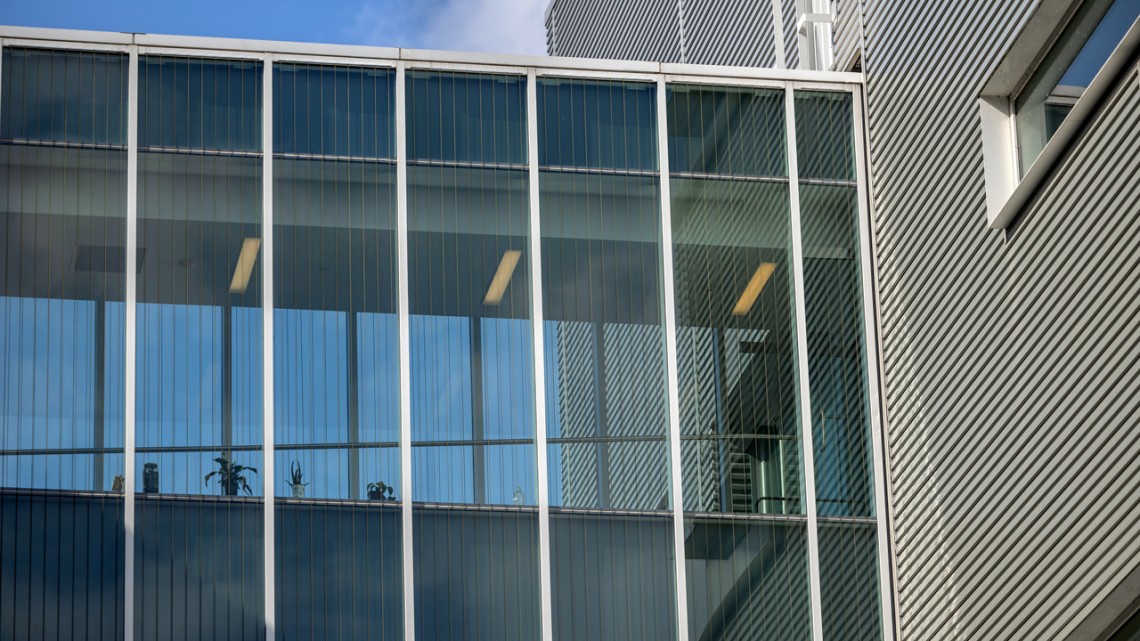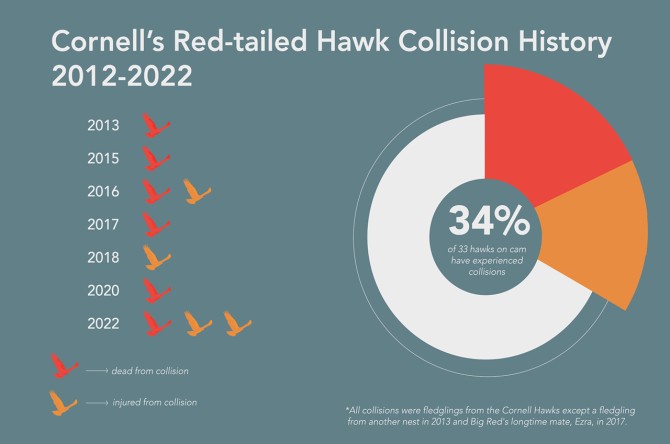
Paracord, installed to deter birds from flying into the glass, seen on the footbridge of Stocking Hall.
Group works to make campus windows bird friendly
By Krishna Ramanujan, Cornell Chronicle
Since summer 2022 – when two recently fledged hawks on campus were injured and a third died after flying into windows – a group of Cornell staff, alumni, students and volunteers has worked to retrofit windows on a few buildings so birds can recognize and avoid them, with plans to address the issue on more around the Ithaca campus.
“Birds hit glass when they’re fooled by trees or skies reflected there, so the trick is to break up reflections,” said Miyoko Chu, senior director of science communications at the Cornell Lab of Ornithology, who is leading the window retrofitting initiative.
Windows, buildings and other structures are major risks to birds, with an estimated 1 billion birds colliding with buildings and windows annually in the U.S. and Canada alone. After habitat loss and cats, windows are the third largest human-caused source of mortality for birds.
At Cornell, millions of viewers enjoy bird cams, including people who follow the beloved matriarch hawk Big Red, her mate Arthur and their fledglings each year. But between 2012 and 2022, more than one-third – 34% – of the 33 hawks recorded on the cam have collided with windows.
“People who watch the cams are so attached to these birds, you really feel like you know them as individuals,” Chu said. “So when these tragic collisions happen, it hits really hard, just as if people were to receive news about any beloved animal they’ve known in person.”
As a result, a Cornell group launched an initiative in 2022 to install cords on windows on campus buildings and tape on bus shelters to help local hawks and other birds, including those that pass through campus during spring and fall migrations, see the glass and break up reflections.
Windows at the Cornell Lab of Ornithology’s Imogene Powers Johnson Center for Birds and Biodiversity were retrofitted last summer with Acopian BirdSavers, which include strands of paracord hung top to bottom over windows and spaced 3.5 to 4 inches apart.
“We wanted to get the glass at the Lab of Ornithology modified for a long time,” said Christine Sheppard ’71, Ph.D. ’77, director of the Glass Collisions Program at the American Bird Conservancy, who has been working with Chu on the initiative to retrofit campus windows. “Having added Acopian BirdSavers at the Lab has allowed us to then start preaching to other people on campus.”
On April 14, the windows of a glass walkway at Stocking Hall were retrofitted with Acopian BirdSavers cording after a hawk fledgling died in a collision there last summer, and another was found injured nearby. And two bus shelters on Tower Road, one of which was the site of a fatal death of a Cornell hawk fledgling in 2016, have been fitted with stripes of white tape to mark the glass.
In August 2022, the university adopted new bird friendly design and construction standards that will guide new construction, including structures, landscaping and window designs, thanks to Chu, Sheppard and others who worked with J. Shermeta, associate university architect at Cornell.
For example, the new Atkinson Hall, to be completed in 2024, will include fritted glass, which has patterns baked into it to reduce reflection and warn birds. Glass companies have increasingly started producing bird friendly glass as more legislation has been adopted, including New York City’s Local Law 15, which requires 90% of the envelope for the first 75 feet from the ground of new construction and major alterations to be made with bird-safe material.
“The great thing about Cornell is that when we started talking to people in facilities, and when we started talking to the Cornell architects, they were all really positive about this,” Sheppard said.
“No one wants birds to be killed just because we’ve designed buildings with beautiful windows for people to see out,” said Matthieu Stratton, business administrator for the Department of Food Science, who was instrumental in coordinating efforts at Stocking Hall where he works.
Last year, Chu hired three students to help with the initiative, which included collecting data of window collision hotspots by developing a route and walking it weekly to monitor for bird deaths. The students found 11 dead birds during their monitoring period and helped identify that along with Stocking Hall, windows at the College of Veterinary Medicine, Mann Library and Trillium, in Kennedy Hall, will be top priority. Conversations have begun to determine the best and most cost-effective solutions in these hotspots.
Ellie VanHouten ’25 said the 11 dead birds they found may represent a fraction of losses when considering the limited hours for surveying, dead birds possibly taken away by scavengers or maintenance staff, and deaths that may have occurred at windows outside of their route. Seven trail cams will soon be installed to record possible scavengers taking more dead or injured birds away. Also, the group has set up an email box where the public can email a photo of a dead or injured bird if they find either on campus, along with the time, location, and photo of the closest building.
“We found several special birds that we didn’t know flew through campus, including a mourning warbler and a rose-breasted grosbeak,” VanHouten said of the dead birds they’ve recovered.
The group is also in discussions with TCAT and facilities managers to continue to retrofit the glass on bus shelters with tape and to identify an effective design. Signage in bus shelters will also explain the purpose of the tape and educate the public on the dangers of windows to birds.
To help fund the project, Lab of Ornithology supporter and hawk-cam viewer Kathryn Cafiero donated $20,000. The gift has helped create a matching-funds program in which the group will split the difference if facilities directors and building managers can contribute half of the money for retrofitting costs.
“The bottom line is that people really care and want to be part of the solution,” Chu said. “Whether they’re building managers, architects, donors, cam watchers or bird lovers, people are coming together on this issue to find ways to move forward.”
Interested people can learn more about preventing bird window strikes here; almost half of all bird-window collisions happen at homes.
Media Contact
Get Cornell news delivered right to your inbox.
Subscribe

